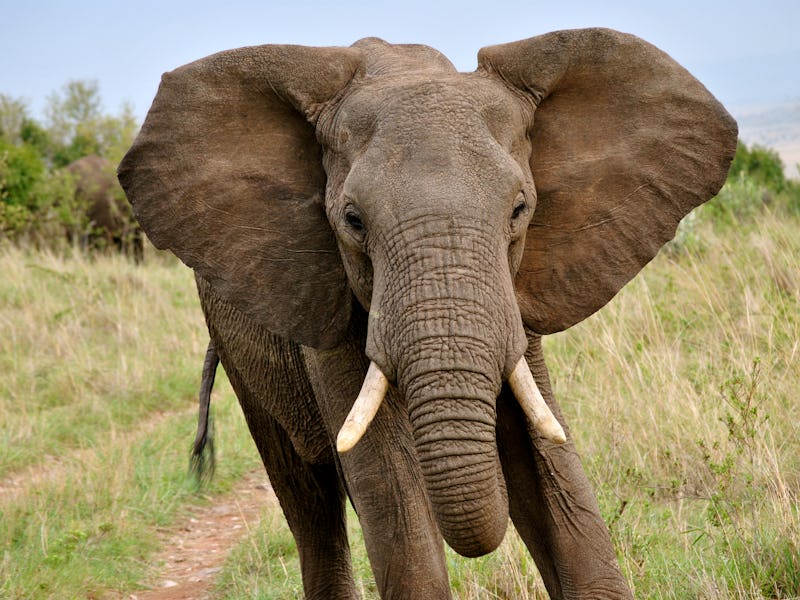When Polar Bears Are No Longer Climate Change Icons, Elephants Will Take Their Place
It's not just about global warming and the Arctic any longer. It's about guns and water.

The polar bear is — and has long been — the mascot for climate change activism. The sea ice platforms they use to hunt seals and not drown doing it are melting, providing photo opportunities, as scientists predict mass die-offs, providing a sense of urgency. But the conversation about climate change is shifting. The arctic is no longer the focal point of concerns and the efficacy of the polar bear as a symbol is now in question.
But is there another animal that could step up to the plate? That could captivate human imaginations and compel them to come together and push for a better future? Inverse spoke with Nikhil Advani, a senior program officer with the World Wildlife Fund, on his top pick, and other strong contenders.
The Elephant
Up until very recently, we’ve thought about climate change impacts on animals almost exclusively in terms of direct effects, explains Advani. So, of course, melting sea ice directly impacts the ability of polar bears to get a meal (although the extent to which the bears will adapt is still a matter of scientific debate). But most charismatic, large mammals are actually quite adaptable to direct climate change effects, says Advani. There’s a bigger, more insidious problem: As humans change their behavior in response to a warming climate, they are increasingly coming into conflict with animals and encroaching on their territory. In drought-stricken Africa, this means humans are competing with animals for scarce water resources in a way they didn’t before. And that’s bad news for the elephant.
Elephants in Amboseli National Park, Kenya.
“Elephants need about 300 liters of water a day, just for drinking. And those water sources are quickly diminishing, in places where they used to be,” says Advani. “We even have anecdotal evidence of people turning to poaching as an alternative source of income, because their crops are failing because of changing rainfall patterns.”
This is notable not only because it’s concerning, but also because mobilizing the public to take on poachers has always been relatively easy. The question is whether people would ever be able to treat them as symptomatic of the problem rather than as a source of ecological infection.
“If you ask people ‘What are the major threats to elephants?’ they’ll say, ‘Poaching, human-wildlife conflict,’ but what I’m really interested is what are the drivers of those threats,” says Advani. “And in many cases, we’re increasingly seeing it eventually being tied back to climate change.”
The Blue Whale
As we become more and more aware of how greenhouse gas emissions are impacting the planet, we’re paying a lot more attention to the oceans. Oceans won’t see the same dramatic temperature changes as on land, but something more terrifying is taking place. The seas are absorbing carbon dioxide from the atmosphere, causing the water to become more acidic. As a result, all sorts of shell-bearing organisms are having a hard time as their exoskeletons literally dissolve into the ocean.
Take krill, for example. One study found that without climate change action 20-70 percent of the tiny shrimp-like creatures could disappear from waters near Antarctica, where they feed seals, whales, penguins, fish, and birds by the billions.
A blue whale's tongue weighs as much as an elephant.
Krill, though, is far too much of a shrimp to take on the polar bear. But what of the blue whale? No animal is more weighty, more poignant in the human imagination, than that massive beast of the sea. And, as it happens, blue whales feast on krill almost exclusively — up to four tons of it a day. It could be that krill become to the blue whale what melting sea ice once was to the polar bear.
The Sea Turtle
Who doesn’t love a sea turtle? They’re gentle, wise, and serene. They’re also directly threatened by climate change.
The most obvious problem is this — the sex of the developing sea turtle egg is determined by the temperature of the sand in which it sits. Usually, this means males will be born from the eggs laid deeper in the sand, while females will hatch nearer to the surface. But warmer beaches results in more lady-turtles, which messes up future reproduction and genetic diversity.
Sea turtles are between a rock and a hard place when it comes to climate change.
Storms, intensified by climate change, also pose a threat to sea turtle eggs. And once the little guys hatch and crawl to the sea, their trouble doesn’t end. Coral bleaching, which can be caused by warm water temperatures or other environmental changes, threatens the ecosystems that sea turtles depend on for food.
Because sea turtles depend on both land and marine environments at different life stages, they could be the species to bridge the gap — a perfect symbol of the many complicated ways that climate change is affecting the animals of the planet.